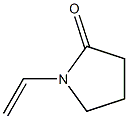25249-54-1

Product Name:
Crospovidone
Formula:
C6H9NO
Synonyms:
PVP;Povidone;PVPP;Polyvinylpolypyrrolidone;Polyvidone
Inquiry
CHEMICAL AND PHYSICAL PROPERTIES
| Physical Description | Polyvinylpyrrolidone is a white powder. Compatible with a wide range of hydrophilic and hydrophobic resins. (NTP, 1992) |
|---|---|
| Color/Form | Faintly yellow solid |
| Odor | ODORLESS |
| Boiling Point | 90-93 °C |
| Melting Point | 100 |
| Flash Point | 95 °C |
| Solubility | greater than or equal to 100 mg/mL at 68 °F (NTP, 1992) |
| Density | 1.23 to 1.29 (NTP, 1992) |
| Vapor Density | Relative vapor density (air = 1): 3.83 |
| Vapor Pressure | 0.1 [mmHg] |
| LogP | log Kow = 0.37 |
| Henry's Law Constant | Henry's Law constant = 5.5X10-8 atm-cu m/mol @ 25 °C /Estimated/ |
| Stability/Shelf Life | Polymerizes readily in the presence of oxygen. |
| Autoignition Temperature | 240 °C |
| Decomposition | When heated to decomposition it emits toxic fumes of nitroxides. /Poly(1-vinyl-2-pyrrolidinone) homopolymer and Hueper's polymer 1-7/ |
| Viscosity | 2.07 cps @ 25 °C |
| pH | Between 3,0 and 7,0 (5 % solution) |
| Refractive Index | Index of refraction = 1.511 @ 25 °C/D |
| Kovats Retention Index | 1077 |
| Other Experimental Properties | A 3.5% soln develops an osmotic pressure of 400 mm water |
| Chemical Classes | Plastics & Rubber -> Other Monomers |
COMPUTED DESCRIPTORS
| Molecular Weight | 111.14 g/mol |
|---|---|
| XLogP3 | 0.4 |
| Hydrogen Bond Donor Count | 0 |
| Hydrogen Bond Acceptor Count | 1 |
| Rotatable Bond Count | 1 |
| Exact Mass | 111.068413911 g/mol |
| Monoisotopic Mass | 111.068413911 g/mol |
| Topological Polar Surface Area | 20.3 Ų |
| Heavy Atom Count | 8 |
| Formal Charge | 0 |
| Complexity | 120 |
| Isotope Atom Count | 0 |
| Defined Atom Stereocenter Count | 0 |
| Undefined Atom Stereocenter Count | 0 |
| Defined Bond Stereocenter Count | 0 |
| Undefined Bond Stereocenter Count | 0 |
| Covalently-Bonded Unit Count | 1 |
| Compound Is Canonicalized | Yes |
PRODUCT INTRODUCTION
description
Polyvinylpyrrolidone is a white powder. Compatible with a wide range of hydrophilic and hydrophobic resins. (NTP, 1992)
